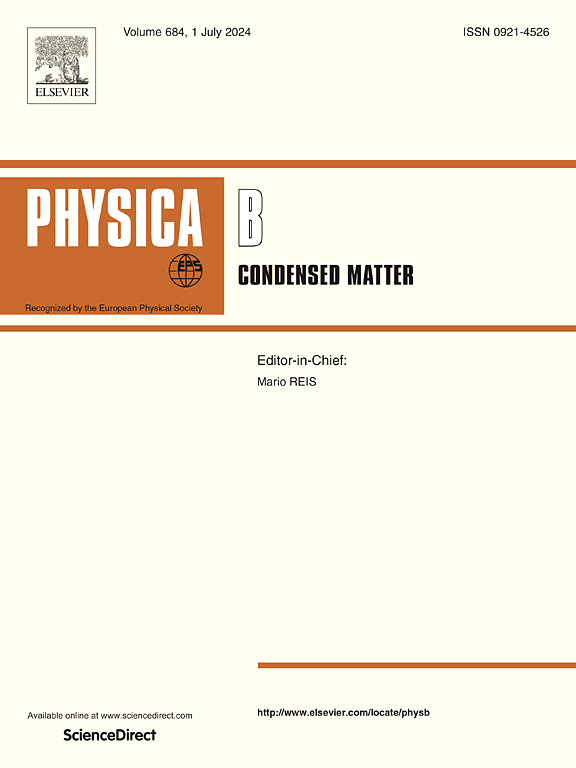合成修饰的混合相逆尖晶石CuFe2O4磁性纳米颗粒:光催化应用的结构、物理和电化学性质
IF 2.8
3区 物理与天体物理
Q2 PHYSICS, CONDENSED MATTER
引用次数: 0
摘要
采用改性共沉淀法(C)、两步水热法(H)和聚合物辅助溶胶-凝胶法(S)制备了晶粒尺寸在21.8 ~ 27.0 nm之间的铁酸铜纳米颗粒。合成条件引起结构和形态的变化,导致它们的光电和电化学性能在特定的光催化应用中变得明显不同。纳米粒子为p型半导体,直接光学带隙在2.06 ~ 2.65 eV之间,载流子浓度在1017 ~ 1018 cm−3之间。磁化研究表明,c -样品的饱和磁化强度为32.44 emu/g,几乎是h -样品(16.4 emu/g)的两倍;而后者的矫顽力最高。阻抗谱揭示了s样品中更快的晶界电子转移动力学。由C-和S-制备的球团由于晶粒尺寸较大,具有较大的介电常数和较好的氧离子导电性。基于密度泛函理论的计算表明,氧离子电导率在空穴传输中起着至关重要的作用,从而增强了光催化性能。h -样品的光催化活性优异,在2小时内亚甲基蓝染料降解程度为55%,在模拟阳光下第一个小时的速率动力学更快,为0.004 min−1。本文章由计算机程序翻译,如有差异,请以英文原文为准。
Synthetically modified mixed phase inverse spinel CuFe2O4 magnetic nanoparticles: Structure, physical, and electrochemical properties for photocatalytic applications
Copper ferrite nanoparticles with crystallite sizes between 21.8 and 27.0 nm are developed by modified co-precipitation (C), two-step hydrothermal (H), and polymer-assisted sol-gel (S) methods. The synthetic conditions caused a structure and morphology variation, resulting in their optoelectrical and electrochemical properties becoming markedly different for specific photocatalytic applications. The nanoparticles are p-type semiconducting with direct optical band-gaps between 2.06 and 2.65 eV and carrier concentrations between 1017 ∼1018 cm−3. Magnetization studies demonstrate that the C-sample exhibits saturation magnetization of 32.44 emu/g nearly double as compared to that of H-sample (16.4 emu/g); however, the latter shows the highest coercivity. Impedance spectroscopy reveals faster electron transfer kinetics across the grain boundaries in the S-sample. The pellets prepared from C- and S- samples have larger dielectric constants and better oxygen ion-led conductivity owing to their larger grain size. Density Functional Theory-based calculation shows that oxygen ion conductivity plays a vital role in hole transport and thus an enhancement in the photocatalytic properties. Photocatalytic activity in the H-sample is superior with a degree of methylene blue dye degradation of 55 % in 2 h and a faster rate kinetics of 0.004 min−1 in the first hour under simulated sunlight.
求助全文
通过发布文献求助,成功后即可免费获取论文全文。
去求助
来源期刊

Physica B-condensed Matter
物理-物理:凝聚态物理
CiteScore
4.90
自引率
7.10%
发文量
703
审稿时长
44 days
期刊介绍:
Physica B: Condensed Matter comprises all condensed matter and material physics that involve theoretical, computational and experimental work.
Papers should contain further developments and a proper discussion on the physics of experimental or theoretical results in one of the following areas:
-Magnetism
-Materials physics
-Nanostructures and nanomaterials
-Optics and optical materials
-Quantum materials
-Semiconductors
-Strongly correlated systems
-Superconductivity
-Surfaces and interfaces
 求助内容:
求助内容: 应助结果提醒方式:
应助结果提醒方式:


